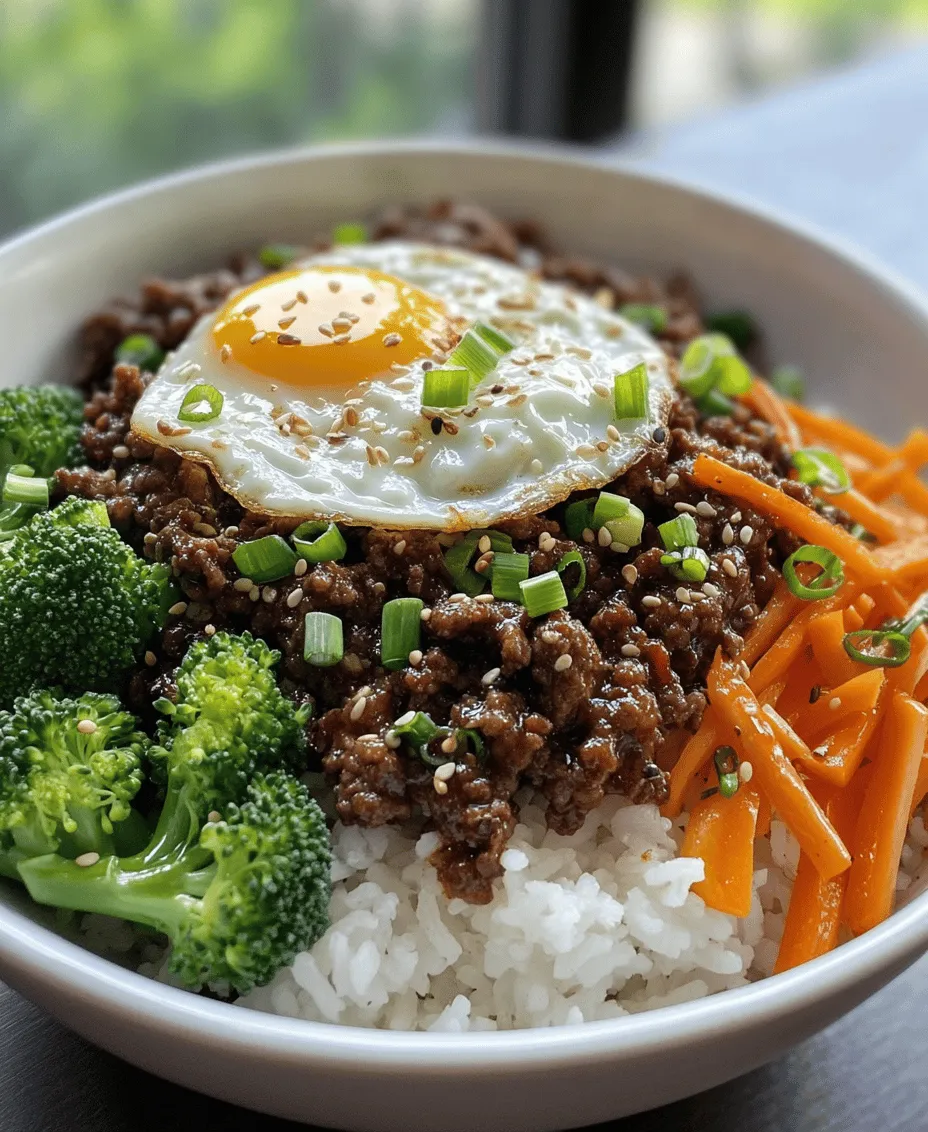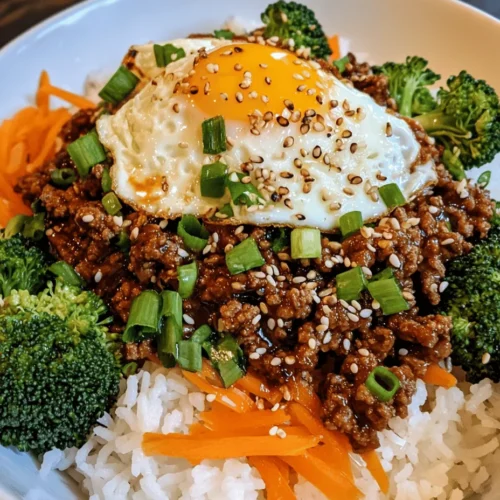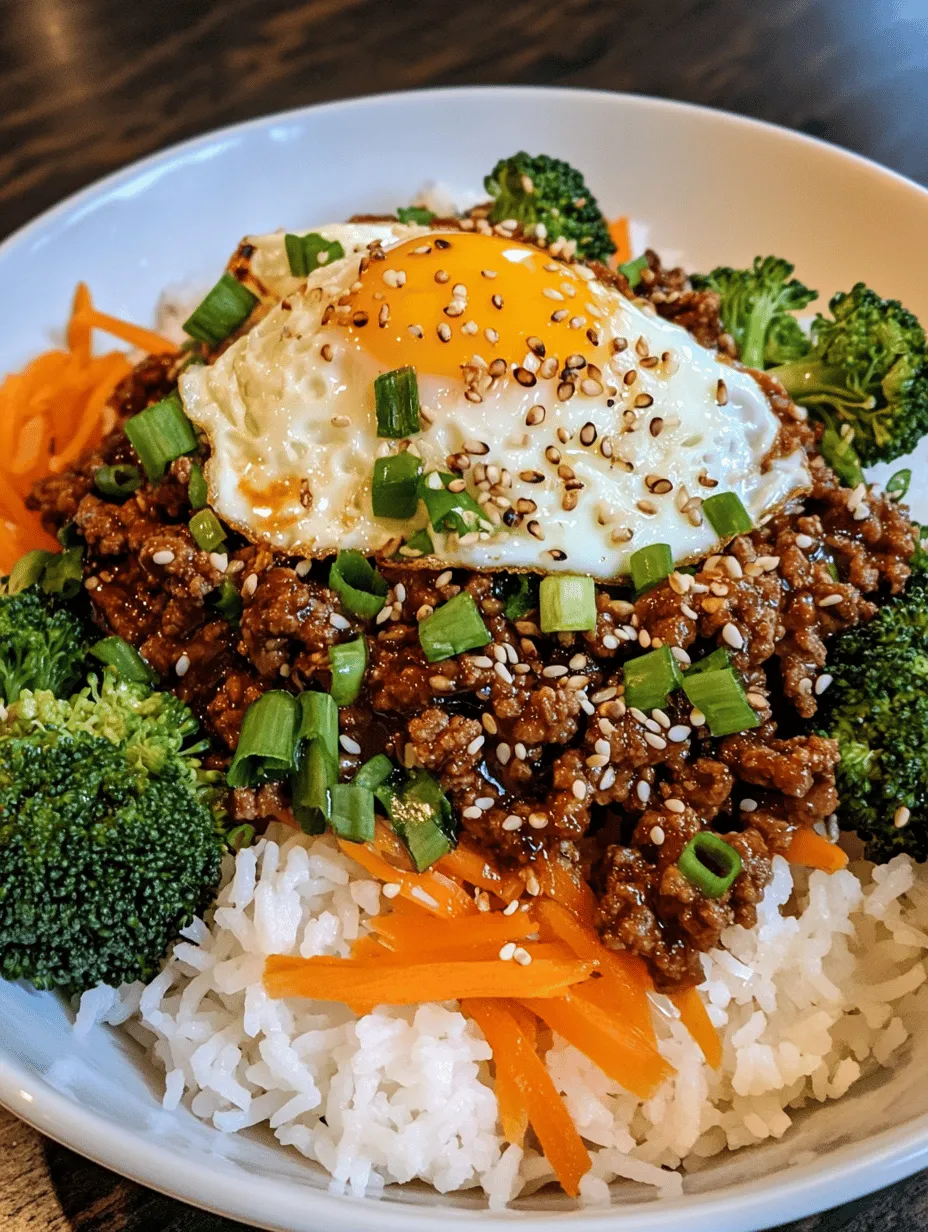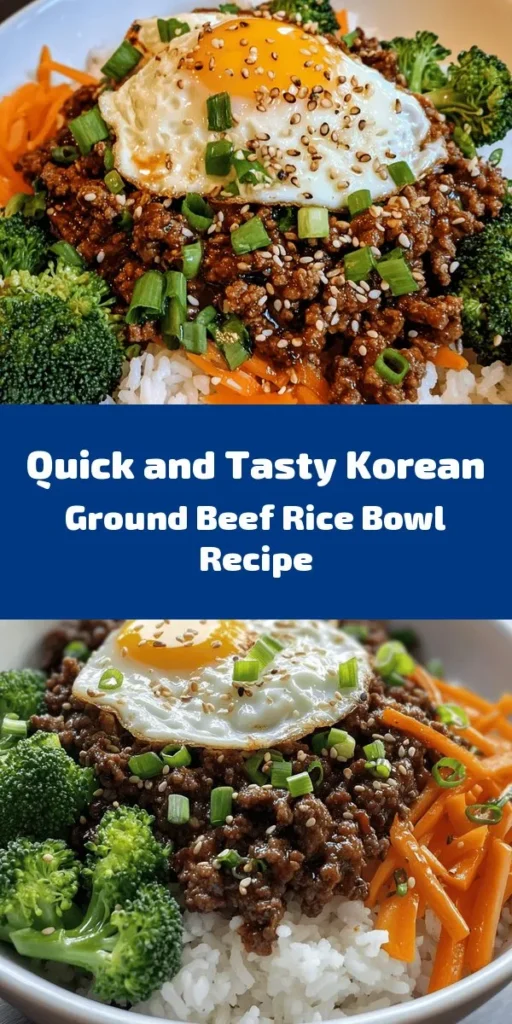Introduction
Korean cuisine has been capturing the hearts and palates of food lovers around the world, thanks to its unique blend of flavors, textures, and ingredients. With its vibrant dishes that often include a variety of spices and fresh produce, Korean food has seen a significant rise in popularity in recent years. One dish that exemplifies the essence of this cuisine is the Korean Ground Beef Bowl. This quick and nutritious meal embodies everything we love about Korean food: it’s flavorful, colorful, and packed with essential nutrients.
The Korean Ground Beef Bowl is not only delicious but also serves as a well-balanced meal that combines protein, vegetables, and carbohydrates. By using ground beef as the main protein source, complemented by a medley of vegetables and served over a bed of rice, this dish is both satisfying and nourishing. Whether you’re a busy professional looking for a quick weeknight dinner or a home cook aiming to impress family and friends, this recipe promises to deliver on taste and convenience.
Understanding the Ingredients
To create a mouthwatering Korean Ground Beef Bowl, it’s essential to understand the key ingredients that make this dish stand out. Each component plays a crucial role in building the flavors and nutritional value of the meal.
Ground Beef
Ground beef is the star of this dish, offering a rich source of protein that helps fuel your body and keep you energized. It is not only affordable and versatile but also quick to cook, making it an ideal choice for busy weeknight meals. The flavor profile of ground beef is enhanced when cooked with the right seasonings, allowing it to absorb the umami notes from the other ingredients in the dish. Additionally, ground beef contains essential nutrients such as iron, zinc, and vitamin B12, which are important for overall health.
Soy Sauce
In Korean cooking, soy sauce is a staple ingredient that brings depth and complexity to dishes. Its umami flavor is unparalleled and is often used to enhance the taste of protein and vegetables alike. By incorporating soy sauce into the Korean Ground Beef Bowl, you’ll not only add saltiness but also a rich, savory flavor that complements the ground beef beautifully. Opting for a low-sodium soy sauce can help control salt intake while still providing that essential flavor boost.
Brown Sugar
The inclusion of brown sugar in this recipe may come as a surprise, but it plays an important role in balancing the savory flavors of the dish. The sweetness of brown sugar helps to counteract the saltiness of the soy sauce and adds a layer of complexity to the flavor profile. It also caramelizes slightly during cooking, giving the ground beef a delicious glaze that enhances its appeal.
Sesame Oil
Sesame oil is another key ingredient in Korean cuisine, known for its nutty flavor and aroma. Used sparingly, it provides a unique taste that elevates the overall dish. Beyond its flavor, sesame oil also boasts health benefits, including anti-inflammatory properties and heart-healthy fats. A drizzle of sesame oil can transform the ordinary into the extraordinary, making it an essential addition to the Korean Ground Beef Bowl.
Garlic and Ginger
Garlic and ginger are two essential aromatics that form the backbone of many Korean dishes. Both ingredients are packed with flavor and health benefits. Garlic adds a pungent, savory note, while ginger brings warmth and a hint of sweetness. Together, they create an aromatic base that enhances the overall flavor of the ground beef, making it irresistible.
Gochujang
One of the most exciting components of the Korean Ground Beef Bowl is gochujang, a traditional Korean chili paste known for its unique flavor profile. Made from fermented soybeans, glutinous rice, and chili powder, gochujang adds heat and depth to the dish. It can range from mildly spicy to quite fiery, depending on the brand and variety used. When added to the ground beef, gochujang not only provides a pleasant kick but also contributes to the dish’s signature flavor.
Rice Vinegar
Rice vinegar is a subtle yet important ingredient in this recipe. It adds a touch of acidity that helps to brighten the overall flavors of the dish. Rice vinegar is milder than regular vinegar, making it a perfect complement to the savory components without overpowering them. A splash of rice vinegar can enhance the taste of the ground beef and vegetables, creating a well-rounded dish.
Vegetables
Vegetables play a vital role in the Korean Ground Beef Bowl, not only for their flavor and texture but also for their nutritional benefits. Broccoli and carrots are commonly used in this dish, contributing vibrant colors and essential vitamins. Broccoli is rich in fiber, vitamins C and K, and antioxidants, while carrots are a great source of beta-carotene and other nutrients that support eye health. Including a variety of vegetables not only boosts the nutritional value but also adds crunch and freshness to the bowl.
Preparation Steps
Creating a Korean Ground Beef Bowl is a straightforward process that can be accomplished in just a few simple steps. Below, we break down the cooking process to ensure you achieve the best results.
Cooking the Beef
Start by heating a large skillet or wok over medium-high heat. Once hot, add a tablespoon of sesame oil, allowing it to coat the bottom of the pan. Add the ground beef, breaking it up with a spatula as it cooks. The goal is to brown the beef evenly, allowing it to caramelize slightly for enhanced flavor. This should take about 5-7 minutes.
As the beef cooks, season it with a pinch of salt and pepper. Once the meat is no longer pink, drain excess fat if necessary. This step is important, especially if you are using higher-fat ground beef, as it can make the dish greasy.
Adding Flavorings
With the beef browned, it’s time to add the flavorings. Incorporate minced garlic and ginger into the pan, stirring them into the beef. The timing of this step is critical; adding aromatics too early can cause them to burn, resulting in a bitter taste. Cook the garlic and ginger for about 1-2 minutes, just until fragrant.
Next, drizzle in the soy sauce and sprinkle the brown sugar over the mixture. Stir well to combine, allowing the sugar to dissolve and the flavors to meld together. This creates a delicious sauce that coats the beef and infuses it with flavor. If you like a bit of heat, this is also the time to add gochujang, adjusting the amount based on your spice tolerance. Continue to cook for another 2-3 minutes, allowing the sauce to thicken slightly.
Preparing the Vegetables
While the beef is simmering with its flavorings, it’s time to prepare the vegetables. Broccoli and carrots can be quickly steamed to retain their bright colors and crunch. Set up a steamer basket over a pot of boiling water, and add the broccoli florets and sliced carrots. Cover and steam for about 3-5 minutes, or until the vegetables are tender yet still crisp.
If you don’t have a steamer basket, you can also microwave the vegetables in a covered bowl with a splash of water for a similar effect. This method is quick and helps to preserve nutrients while ensuring the vegetables maintain their vibrant colors.
Once the vegetables are ready, you can either mix them into the beef mixture or serve them on the side. Both options work beautifully—mixing them in allows for a more cohesive dish, while serving them separately provides a lovely presentation.
By following these steps, you’re well on your way to creating a delightful Korean Ground Beef Bowl that is sure to impress. The combination of flavors and textures, along with the health benefits of the ingredients, makes this dish a standout option for any meal. With a little preparation and the right techniques, you can enjoy a taste of Korea right in your own kitchen.

Assembling the Bowl
Presentation is key when it comes to making your Korean Ground Beef Bowl visually appealing. A well-assembled bowl not only enhances the dining experience but also entices the appetite. Here are some tips for assembling your bowl:
1. Base Layer: Start with a generous scoop of your chosen base, whether it’s fluffy white rice, brown rice, or quinoa. Spread it evenly across the bottom of the bowl to create a solid foundation.
2. Beef Placement: Next, add a portion of the sautéed ground beef mixture. Place it in the center of the bowl, allowing it to mound slightly. This creates a focal point for your dish.
3. Vegetable Arrangement: Surround the beef with colorful vegetables. Use a rainbow of fresh veggies such as sliced cucumbers, shredded carrots, and sautéed bell peppers. The vibrant colors not only make the dish more appealing but also signify a variety of nutrients.
4. Garnishing: Sprinkle sesame seeds and chopped green onions over the top of the beef for added texture and flavor. A drizzle of soy sauce or a dollop of gochujang can serve as a final touch, adding both flavor and a pop of color.
5. Add a Soft Boiled Egg: If you want to elevate your bowl further, consider adding a soft-boiled egg on top. The creamy yolk will meld beautifully with the beef and rice, creating a delightful richness.
6. Serving Dish: Use a wide, shallow bowl to allow all the colors and textures to shine. This style of presentation is not only traditional in Korean culture but also practical for enjoying all the components together.
Nutritional Analysis
Understanding the nutritional value of the Korean Ground Beef Bowl can help you feel good about what you’re eating. Here’s a breakdown:
– Caloric Breakdown: A typical serving of the Korean Ground Beef Bowl, which includes ground beef, rice, and assorted vegetables, can range between 500 to 700 calories, depending on portion sizes and specific ingredients used. This includes approximately:
– Ground Beef (3 oz): 250 calories
– Cooked White Rice (1 cup): 200 calories
– Assorted Vegetables (1 cup): 50 calories
– Additional toppings (like avocado or boiled egg): 100-200 calories depending on choice
– Health Benefits: This dish packs a nutritional punch:
– Protein: Ground beef is an excellent source of protein, essential for muscle repair and growth.
– Vitamins and Minerals: Fresh vegetables provide vital vitamins, minerals, and antioxidants that support overall health and well-being.
– Healthy Fats: Adding toppings like avocado can introduce healthy fats that promote heart health and keep you satiated longer.
– Alternative Ingredients: For those who are health-conscious or have dietary preferences, consider these alternatives:
– Brown Rice: Switch white rice for brown rice to increase fiber content, which aids digestion and promotes a feeling of fullness.
– Ground Turkey or Chicken: These leaner meats can reduce the overall calorie count while still providing a satisfying flavor.
– Plant-Based Options: For a vegetarian or vegan option, consider using tofu or tempeh as a protein substitute.
Customization Options
One of the best aspects of the Korean Ground Beef Bowl is its flexibility. Here are some suggestions for customizing your dish:
– Ingredient Substitutions: If you’re looking for healthier options or different flavors, try:
– Ground Turkey or Chicken: For a leaner protein option that still delivers great taste.
– Tofu or Tempeh: Excellent for vegetarians, these plant proteins absorb flavors well and provide a satisfying texture.
– Additional Toppings: Elevate your bowl with various toppings:
– Avocado: Adds creaminess and healthy fats.
– Kimchi: A traditional fermented side that complements the flavors and adds probiotics for gut health.
– Nuts or Seeds: Toasted sesame seeds or crushed peanuts can add a delightful crunch.
– Seasonal Variations: Adapt your bowl according to the season:
– Spring: Incorporate snap peas and radishes for a fresh, crisp taste.
– Summer: Use grilled zucchini and corn for a smoky flavor.
– Fall: Sweet potatoes and roasted Brussels sprouts can add warmth and heartiness.
– Winter: Incorporate hearty greens like kale or bok choy for added nutrition.
Cultural Context
Korean bowls, known as “bibimbap,” hold significant cultural importance in Korea. This dish is traditionally served as a mixed rice bowl topped with a variety of ingredients, including vegetables, meat, and gochujang (Korean chili paste). Each ingredient represents different aspects of Korean culture, such as harmony and balance, making it a meal deeply rooted in tradition.
– Significance in Everyday Meals: Bibimbap is often considered a symbol of communal eating. In Korean culture, meals are typically enjoyed with family or friends, and the act of mixing the ingredients reflects unity and togetherness. The customizable nature of the dish allows for personal preferences and dietary needs to be met.
– Exploration of Similar Dishes: Other cultures feature similar mixed rice dishes. For example:
– Japanese Donburi: A rice bowl topped with ingredients like meat, fish, or vegetables.
– Mexican Burrito Bowls: A bowl filled with rice, beans, meat, and various toppings, reflecting a customizable approach similar to Korean bowls.
– Korean Food in Modern Dining: Korean cuisine has gained immense popularity worldwide, with dishes like Korean BBQ and kimchi becoming staples in many households. The emphasis on fresh ingredients, bold flavors, and health benefits makes Korean food a favored choice for both casual dining and meal prep.
Serving Suggestions
To create a complete meal experience, consider these serving suggestions:
– Recommended Sides: Enhance your Korean Ground Beef Bowl with complementary sides:
– Pickled Vegetables: A traditional side, pickled radishes or cucumbers add a refreshing crunch and balance out the savory flavors of the bowl.
– Seaweed Salad: This light and nutritious salad pairs well with the richness of the meat and rice.
– Miso Soup: A warm bowl of miso soup serves as a great starter, providing umami flavor and warmth.
– Beverage Pairings: The right drink can elevate your meal:
– Korean Soju: A popular Korean spirit, soju can enhance the dining experience, particularly when sharing the meal with friends.
– Green Tea: A calming beverage that complements the flavors of the dish without overpowering them.
– Sparkling Water with Lemon: For a refreshing non-alcoholic option, sparkling water can cleanse the palate between bites.
Conclusion
The Korean Ground Beef Bowl stands out as a quick, healthy, and incredibly flavorful dish that can easily fit into any meal plan. Its versatility allows for endless customization, making it a favorite among home cooks and food enthusiasts alike. By exploring Korean cuisine further, you can uncover a wealth of delicious recipes that celebrate fresh ingredients and bold flavors.
Making this dish at home not only satisfies your cravings but also provides a fulfilling cooking experience. The ease of preparation, combined with the joy of assembling a visually appealing bowl, makes it a perfect choice for both busy weeknights and leisurely weekend meals. Embrace the flavors of Korea and bring this delightful dish into your kitchen today!



